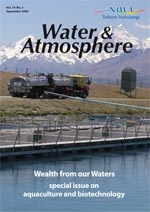PDF of this article (142 KB)

Kingfish gone wild


In July, NIWA joined the mobilisation of effort across several sectors of New Zealand’s fishing and aquaculture industry. The ‘Kingfish Go Wild’ project was organised by the New Zealand Recreational Fishing Council (NZRFC) and supported by Sanford Seafood Ltd. The project’s purpose was to release into the wild kingfish from the Parengarenga Fishfarm in Northland, which has gone out of business. The fish were otherwise destined to become crayfish bait.
NIWA’s expertise in fish husbandry and transport was brought in to ensure the safe delivery and release of the fish. Over the course of a week, NIWA delivered over 5000 kingfish, averaging about a kilo each, to six sites in the upper part of the North Island: the Noisies in Hauraki Gulf, Raglan Wharf, and the boat ramps at Mangonui, Whangaroa, Houhora, and Russell. Sixteen hundred of the fish were individually identified using specially made tags bearing the project logo.
For further information, contact: Dr Michael Bruce, 0-9-375 2035, [email protected]
Or visit www.fishing.net.nz and search on ‘kingfish go wild’.
Workshop gets to grip with deep-sea corals


Visiting corals expert Dr Juan A. Sánchez, of the Universidad de los Andes in Bogotá, Colombia, ran a one-day coral identification workshop at NIWA’s Wellington site in July.
NIWA scientists who attended the workshop included taxonomists (who identify and formally classify species), parataxonomists (trained in species identification), and biologists carrying out research work on some of New Zealand’s most important coral species. Participants spent a day working with the numerous coral specimens held in the NIWA National Invertebrate Collection.
Deep-sea corals are widely distributed in New Zealand’s EEZ, occurring on seamounts as well as in relatively flat areas and on deep-sea reefs. Many live well below 1000 m depth. Corals provide an ideal habitat for small invertebrates and shelter for fish. They also hold invaluable information about past climate events and the age of deepwater coral communities.
The New Zealand region contains a remarkably diverse array of deep-sea corals. Little is known for certain groups of corals, and some New Zealand species remain unidentified and undescribed. The main groups in our waters comprise scleractinians or stony corals, hydrocorals, soft corals, gorgonian corals, sea pens, and black corals.
Workshop participants began by familiarising themselves with the specimens, working out what groups of corals they could immediately identify, and learning key features for distinguishing the main species within the different groups. Useful identifiers are the shape and structure of corals and their calyces (cups), the distribution of the polyps (the parts of the coral animal that extend to feed or retract to hide within the calyces), branching patterns, colours, and spicule (spine) shape. Microscopes and scanning electron microscope (SEM) imaging are required for identifying spicules.
Next, Juan focused on identification within the groups. For instance, the four main stony coral species can be distinguished by examining their calyces and the branching pattern as the colony grows. Within the soft corals, some have a gigantic polyp that looks like a volcano, others are thin and long with runners, or mushroom-like with multiple polyps. Gorgonians comprise the golden corals and have various shapes: delicate bottlebrush-like, twisted, or whip-like, each one a different species; the bamboo corals with white (calcite) and brown (organic) internodes and a variety of branching forms; and, finally, the stunning bubblegum corals, which, depending on the genus, are pink and red, white, or beige.
The workshop participants will apply their sharpened coral ID skills to a variety of projects, including surveying seamount and seep biodiversity, compiling invertebrate guides, mapping coral distribution, and monitoring fisheries bycatch.
For further information, contact: Di Tracey, 0-4-386 0866, [email protected]
Learn more about deep-sea corals
Sánchez, J. (2005). Bubblegum corals from New Zealand seamounts and the deep sea. Water & Atmosphere 13(2): 12–13.
Tracey, D. et al. (2003). Chronicles of the deep: ageing deep-sea corals in New Zealand waters. Water & Atmosphere 11(2): 22–24.
